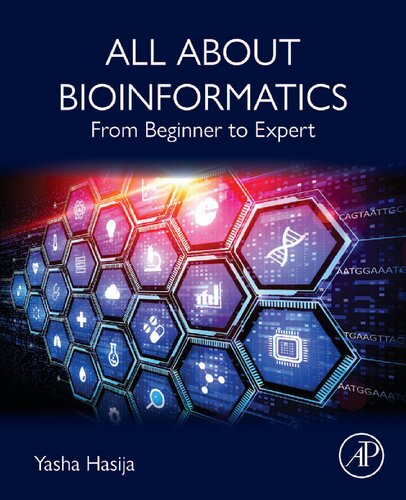(Ebook) All About Bioinformatics: From Beginner to Expert by Yasha Hasija ISBN 9780443152504, 0443152500
All About Bioinformatics: From Beginner to Expert provides readers with an overview of the fundamentals and advances in the field of bioinformatics, as well as some future directions. Each chapter is didactically organized and includes introduction, applications, tools, and future directions to cover the topics thoroughly.The book covers both traditional topics such as biological databases, algorithms, genetic variations, static methods, and structural bioinformatics, as well as contemporary advanced topics such as high-throughput technologies, drug informatics, system and network biology, and Machine Learning. It is a valuable resource for researchers and graduate students who are interested to learn more about bioinformatics to apply in their research work.A Machine Learning algorithm is a statistical computation method used in software to detect hidden patterns that are not obvious in a dataset and make reliable statistical predictions of similar new data. Machine Learning techniques attempt to find a pattern in a particular dataset; using these learned patterns, a similar pattern in a new dataset is identified. Machine Learning processes are somewhat close to statistical modeling and data collection. They look into the data to find trends and accordingly learn the pattern or parameters. We usually know about Machine Learning through social media connection suggestions, online shopping product recommendations, spam filters in our email inboxes etc.Recent advances in the life and Computer Sciences have permitted the use of computational techniques to address critical problems. Python is a free general-purpose programming language that is simple to learn and apply to a wide range of computational tasks. Python may be used to handle a variety of difficulties that research labs confront on a daily basis. Using computers and an appropriate programming language, it is possible to execute tasks such as data manipulation, biological data retrieval and parsing, automation, and simulation of biological problems efficiently. The goal of this chapter is to give a high-level look at the Python programming language, showing how it works and what it can do. The main data structures and flow control statements are shown. Following these fundamental concepts, topics such as file access, functions, and modules are addressed in greater depth. This chapter introduces the reader to Anaconda, a distribution software that includes libraries, packages, and editors (such as Jupyter notebooks) essential for Python development. The datatypes, regularly used operators in each datatype, and a range of helpful built-in data structures, such as strings, lists, tuples, and dictionaries, are introduced. Iterations are also described using terms such as while and for loops. Finally, objects and modules were introduced, and their use in data processing was described. At the end, there are references to more advanced Python topics.- Presents a holistic learning experience, beginning with an introduction to bioinformatics to recent advancements in the field- Discusses bioinformatics as a practice rather than in theory focusing on more application-oriented topics as high-throughput technologies, system and network biology, and workflow management systems- Encompasses chapters on statistics and Machine Learning to assist readers in deciphering trends and patterns in biological data
*Free conversion of into popular formats such as PDF, DOCX, DOC, AZW, EPUB, and MOBI after payment.


